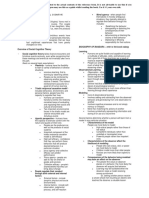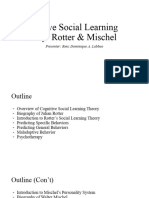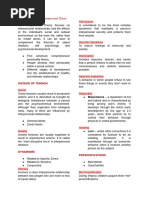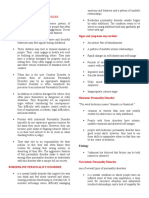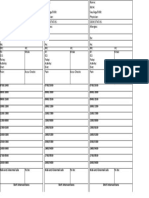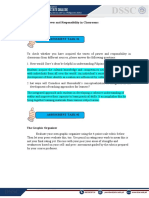Cluster A (Odd/eccentric) : Paranoid Schizoid Schizotypal
Uploaded by
nursekatieCluster A (Odd/eccentric) : Paranoid Schizoid Schizotypal
Uploaded by
nursekatieCluster A (odd/eccentric)
Paranoid Schizoid Schizotypal
Characterized by Distrust And Characterized Emotional Detachment, Characterized by Odd Beliefs, leading to
Suspiciousness Towards Others, based on disinterest in close relationships, and interpersonal difficulties, an eccentric
the belief (unsupported by evidence) that indifference to praise or criticism; often appearance, and magical thinking or
others want to exploit, harm, or deceive the uncooperative. perceptual distortions that are not clear
person. These individuals are: delusions or hallucinations.
-Hypervigilant
The person with this disorder does not seek
-Anticipate hostility out or enjoy close relationships. These
individuals may be able to function in a solitary
-May provoke hostile responses by initiating a occupation.
“counterattack”
-Demonstrate jealousy, controlling behaviors,
and unwillingness to forgive. Schizoid PD can be a precursor to
schizophrenia or delusional disorder. There is
increased prevalence of the disorder in
families with schizophrenia or schizotypal PD.
**Paranoid people are difficult to interview b/c
they are reluctant to share information about
themselves
Nursing Interventions: MANIPULATIVE BEHAVIOR
• Objective, matter-of-fact approach SET LIMITS!!
• Avoid being too “nice or friendly” -Discuss concerns about behavior with patient
• Clear, simple, consistent verbal-non-verbal -identify undesirable behavior, and discuss with patient what is
communication desirable behavior in a give situation or setting
• Give clear straightforward explanations -Establish consequences for occurrence or nonoccurrence of
desired behavior in a non punitive ad easily understood way
• Warn about changes, side effects etc
-Refrain from arguing or bargaining with patient about
• Help identify feelings established behavioral expectations and consequences
• Assist with problem-solving -Modify behavioral expectations as needed based on reasonable
changes in patient’s situations
• Gradually involve in group situations but do not insist.
Respect need for social isolation.
Cluster B (Dramatic/Emotional/Erratic)
Antisocial Borderline Histrionic Narcissistic
Characterized by consistent Characterized by Instability of Characterized by Emotional Characterized by Arrogance,
Disregard for Others with Affect, identity and Relationships; Attention-Seeking Behavior, in Grandiose Views of Self-
exploitation and repeated unlawful fear of abandonment, splitting which the person needs to be the Importance, the need for constant
actions, deceit and failure to behavior, manipulation, and center of attention; often seductive admiration along with a lack of
accept personal responsibility. impulsiveness; often tries self- and flirtatious, the histrionic empathy for others that strains
mutilation and may be suicidal. person is impulsive and most relationships; often sensitive
Previously called Psychopaths or to criticism. Underneath the
melodramatic. Relationships do
Sociopaths. There is a clear Individuals w/ Borderline PD surface of arrogance, narcissistics
not last b/c their partner often
history of conduct disorder in desperately seek relationships to feel intense shame and fear that if
feels smothered or reacts to the
childhood, and the individual show avoid feelings of abandoned, but they are “bad” they will be
insensitivity of the histrionic
no remorse for hurting others. often drive others away b/c of their abandoned. They are afraid of
person. The individual with
They repeatedly: excessive demands, impulsive their own mistakes, as well as the
histrionic PD has no insight into
behavior, and their frequent use of mistakes of others. May seek
-Neglect responsibilities his role in breaking up
splitting. help, feeling that loved ones do
relationships. In the treatment
-Tell lies setting, the person demands “the not show enough appreciation of
best of everything” and can be their special qualities
-Perform destructive or illegal very critical
acts, without developing any
insight into predictable
consequences.
Nursing Interventions IMPULSIVE BEHAVIOR
• Prevent self-harm. No harm contract. IMPULSE CONTROL TRAINING!!
• Set limits on inappropriate or manipulative behaviors -Assist pt to: Identify problem or situation that requires thoughtful action,
and courses of possible actions, their costs or benefits
• Provide clear, consistent boundaries
-Teach pt to cue himself to “stop and think” before acting impulsively
• Assist examining consequences of behavior.
-Assist pt to evaluate the outcome of the chosen course or action
• Consistent approach by staff
-Provide positive reinforcement for successful outcomes (e.g. praise and
• Do not rescue or reject rewards)
• Remain neutral, avoid engaging in power struggles or be coming -Provide opportunities for pt to practice problem solving in social and
defensive to patient’s comments interpersonal situations outside the therapeutic environment
• Give recognition for goal achievement
• Explore feelings
• Teach problem solving and role model assertiveness
• Encourage and model concrete and descriptive communication
• Document behaviors and incidents objectively
• Encourage follow up treatment
Cluster C (Anxious/Fearful/Insecure/Inadequate)
Avoidant Dependant Obsessive Compulsive
Characterized by Social Inhibition and Avoidance
of all situations that require interpersonal contact, Characterized by Extreme Dependency in a close Characterized by Perfectionism with a focus on
despite wanting close relationships, due to extreme Relationship with an urgent search to find a orderliness and control .They become so
fear of rejection; often very anxious in social replacement when one relationship ends; the most preoccupied with details and rules that they may not
situations. frequently-seen personality disorder in the clinical be able to accomplish a given task. Persons with
setting. Individuals with Dependent PD have Obsessive-Compulsive PD feel genuine affection for
Because in their social presentation they appear difficulty making independent decisions and are friends and family, and don’t have insight about their
timid and with low self-esteem and poor self-care, constantly seeking reassurance. Their own difficult behavior creating tension in their close
they are often mistreated in groups. If they do submissiveness makes them vulnerable to abusive relationships, in which the person tries to control the
develop relationships, they cling to their partners in relationships. The have a deeply held conviction of partner.
a dependent way. They are seen in Tx for symptoms personal incompetence that they cannot survive on
of anxiety. their own.
Nursing Interventions: AGGRESSIVE BEHAVIOR
• Caring consistent approach ANGER CONTROL ASSISTANCE!!
• Clear expectations for behavior -Determine appropriate behavioral expectations for expressions of
anger, given pt’s level of cognitive and physical functioning
• Expect patient to make decisions
-Limit access to frustrating situations until pt is able to express anger in
• Teach assertiveness an adaptive manner
• Encourage to identify positive attributes -Encourage pt to seek assistance from nursing staff during periods of
increasing tension
• Provide positive feedback for increased interactions in social
situations -Monitor potential for inappropriate aggression and intervene before its
expression
• Teach stress management and relaxation techniques
-Assist pt in identifying source of anger
-Prevent physical harm if anger is directed towards self or others
-Provide physical outlets for expressions of anger or tension (e.g.
pushing bag, sports, clay, journal writing)
You might also like
- Ferraro, Escalas, Bettman - 2011 - Our Possessions, Our Selves Domains of Self-Worth and The Possession-Self Link-AnnotatedNo ratings yetFerraro, Escalas, Bettman - 2011 - Our Possessions, Our Selves Domains of Self-Worth and The Possession-Self Link-Annotated9 pages
- Compilation of Psychological Test ReportsNo ratings yetCompilation of Psychological Test Reports33 pages
- Instroduction Clinical Assessment of Child and Adolescent PDF100% (1)Instroduction Clinical Assessment of Child and Adolescent PDF18 pages
- A Case From A Psychoanalytic PerspectiveNo ratings yetA Case From A Psychoanalytic Perspective3 pages
- Cross-cultural-adaptation-and-validation-of-the-highly-sensi100% (1)Cross-cultural-adaptation-and-validation-of-the-highly-sensi12 pages
- Types of Anxiety According To Sigmnd Freud100% (1)Types of Anxiety According To Sigmnd Freud13 pages
- What Is Psychoanalytic Therapy: Dream Interpretation: According To Freud, Dream Analysis Is by Far TheNo ratings yetWhat Is Psychoanalytic Therapy: Dream Interpretation: According To Freud, Dream Analysis Is by Far The2 pages
- Chapter 13 Clinical and Counseling AssessmentNo ratings yetChapter 13 Clinical and Counseling Assessment9 pages
- Adolescence Characteristics and ProblemsNo ratings yetAdolescence Characteristics and Problems29 pages
- Psy 1303 - Psychological Report Assessment DetailsNo ratings yetPsy 1303 - Psychological Report Assessment Details1 page
- Abnormal Psychology: Causal Factors and Viewpoints100% (1)Abnormal Psychology: Causal Factors and Viewpoints9 pages
- Dependent Personality Inventory-Revised (DPI-R) - Incorporating ANo ratings yetDependent Personality Inventory-Revised (DPI-R) - Incorporating A85 pages
- Adult Autism Spectrum Assessment RAADS RNo ratings yetAdult Autism Spectrum Assessment RAADS R5 pages
- Role of Attribution and Attitudes in Cognizing Others100% (1)Role of Attribution and Attitudes in Cognizing Others3 pages
- Diagnostic Applications of The Hand Test: Edwin E. WagnerNo ratings yetDiagnostic Applications of The Hand Test: Edwin E. Wagner2 pages
- Cultural Empathy: Description of The Multicultural Personality Questionnaire (MPQ)No ratings yetCultural Empathy: Description of The Multicultural Personality Questionnaire (MPQ)5 pages
- Accurate Expression and Validation 2010No ratings yetAccurate Expression and Validation 201030 pages
- Clinical Psychology - Chapter 10 FlashcardsNo ratings yetClinical Psychology - Chapter 10 Flashcards4 pages
- Comparison of Self-Report and Overt-Behavioral Procedures For Assessing AcrophobiaNo ratings yetComparison of Self-Report and Overt-Behavioral Procedures For Assessing Acrophobia7 pages
- Chapter 12 Summary Abnormal Psychology An Integrative ApproachNo ratings yetChapter 12 Summary Abnormal Psychology An Integrative Approach12 pages
- Signs and Symptoms May Include:: Cluster B Anti Social Personality Disorder100% (1)Signs and Symptoms May Include:: Cluster B Anti Social Personality Disorder2 pages
- Development of The Kalmer Relaxation Intervention Co Design With Stroke Survivors With AphasiaNo ratings yetDevelopment of The Kalmer Relaxation Intervention Co Design With Stroke Survivors With Aphasia14 pages
- Safety Science: Jean Christophe Le CozeNo ratings yetSafety Science: Jean Christophe Le Coze10 pages
- Hanggi1989 - Differential Aspects of Visual Short and Long-Term MemoryNo ratings yetHanggi1989 - Differential Aspects of Visual Short and Long-Term Memory9 pages
- Critical Paper On "Surf" Detergent Product TVCNo ratings yetCritical Paper On "Surf" Detergent Product TVC2 pages
- SHAMDASANI Psychotherapy - The Invention of A WordNo ratings yetSHAMDASANI Psychotherapy - The Invention of A Word22 pages
- The Impact of Stress Management On Nurse Productivity and RetentiNo ratings yetThe Impact of Stress Management On Nurse Productivity and Retenti10 pages
- The Impact of Listening To Music On Cognitive Performance - Inquiries JournalNo ratings yetThe Impact of Listening To Music On Cognitive Performance - Inquiries Journal15 pages
- Planificación Ingles Noveno Bloque CuatroNo ratings yetPlanificación Ingles Noveno Bloque Cuatro1 page
- Get The loss of sadness how psychiatry transformed normal sorrow into depressive disorder 1st Edition Allan V. Horwitz PDF ebook with Full Chapters Now100% (11)Get The loss of sadness how psychiatry transformed normal sorrow into depressive disorder 1st Edition Allan V. Horwitz PDF ebook with Full Chapters Now50 pages
- Pple Assessment 2 Reflection - Philosophy of Classroom ManagementNo ratings yetPple Assessment 2 Reflection - Philosophy of Classroom Management16 pages
- Ferraro, Escalas, Bettman - 2011 - Our Possessions, Our Selves Domains of Self-Worth and The Possession-Self Link-AnnotatedFerraro, Escalas, Bettman - 2011 - Our Possessions, Our Selves Domains of Self-Worth and The Possession-Self Link-Annotated
- Instroduction Clinical Assessment of Child and Adolescent PDFInstroduction Clinical Assessment of Child and Adolescent PDF
- Cross-cultural-adaptation-and-validation-of-the-highly-sensiCross-cultural-adaptation-and-validation-of-the-highly-sensi
- What Is Psychoanalytic Therapy: Dream Interpretation: According To Freud, Dream Analysis Is by Far TheWhat Is Psychoanalytic Therapy: Dream Interpretation: According To Freud, Dream Analysis Is by Far The
- Psy 1303 - Psychological Report Assessment DetailsPsy 1303 - Psychological Report Assessment Details
- Abnormal Psychology: Causal Factors and ViewpointsAbnormal Psychology: Causal Factors and Viewpoints
- Dependent Personality Inventory-Revised (DPI-R) - Incorporating ADependent Personality Inventory-Revised (DPI-R) - Incorporating A
- Role of Attribution and Attitudes in Cognizing OthersRole of Attribution and Attitudes in Cognizing Others
- Diagnostic Applications of The Hand Test: Edwin E. WagnerDiagnostic Applications of The Hand Test: Edwin E. Wagner
- Cultural Empathy: Description of The Multicultural Personality Questionnaire (MPQ)Cultural Empathy: Description of The Multicultural Personality Questionnaire (MPQ)
- Comparison of Self-Report and Overt-Behavioral Procedures For Assessing AcrophobiaComparison of Self-Report and Overt-Behavioral Procedures For Assessing Acrophobia
- Chapter 12 Summary Abnormal Psychology An Integrative ApproachChapter 12 Summary Abnormal Psychology An Integrative Approach
- Signs and Symptoms May Include:: Cluster B Anti Social Personality DisorderSigns and Symptoms May Include:: Cluster B Anti Social Personality Disorder
- Development of The Kalmer Relaxation Intervention Co Design With Stroke Survivors With AphasiaDevelopment of The Kalmer Relaxation Intervention Co Design With Stroke Survivors With Aphasia
- Hanggi1989 - Differential Aspects of Visual Short and Long-Term MemoryHanggi1989 - Differential Aspects of Visual Short and Long-Term Memory
- SHAMDASANI Psychotherapy - The Invention of A WordSHAMDASANI Psychotherapy - The Invention of A Word
- The Impact of Stress Management On Nurse Productivity and RetentiThe Impact of Stress Management On Nurse Productivity and Retenti
- The Impact of Listening To Music On Cognitive Performance - Inquiries JournalThe Impact of Listening To Music On Cognitive Performance - Inquiries Journal
- Get The loss of sadness how psychiatry transformed normal sorrow into depressive disorder 1st Edition Allan V. Horwitz PDF ebook with Full Chapters NowGet The loss of sadness how psychiatry transformed normal sorrow into depressive disorder 1st Edition Allan V. Horwitz PDF ebook with Full Chapters Now
- Pple Assessment 2 Reflection - Philosophy of Classroom ManagementPple Assessment 2 Reflection - Philosophy of Classroom Management









